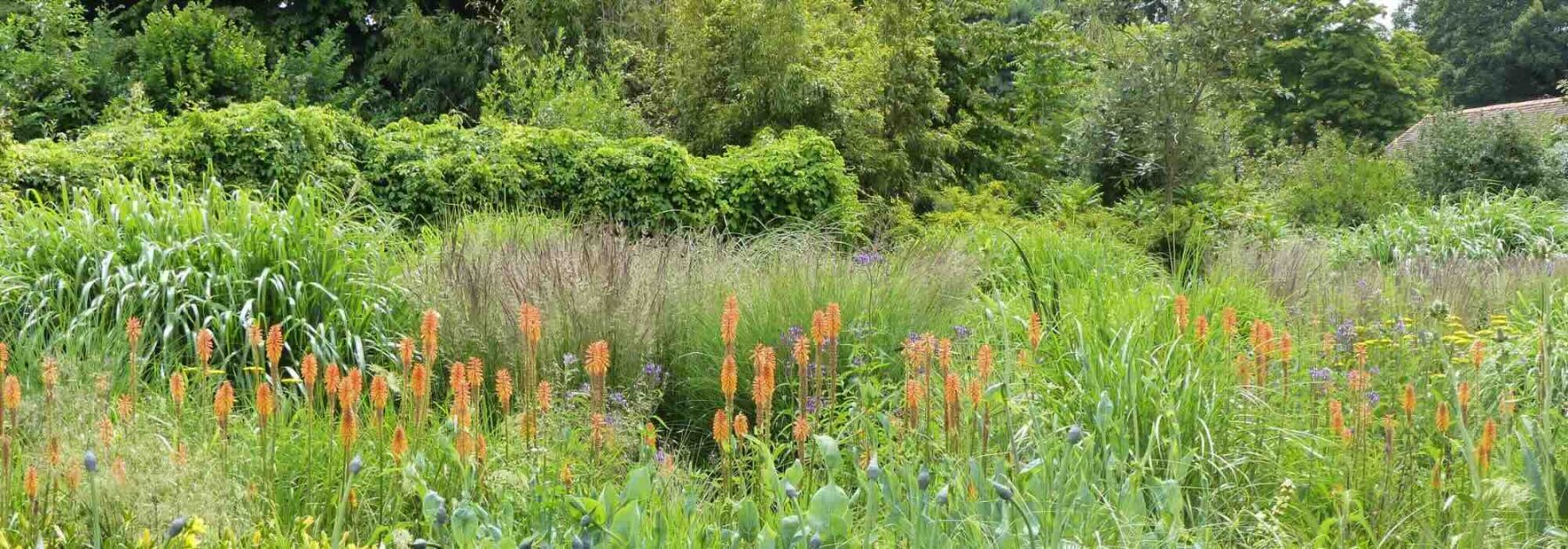
XXL Grasses: The Must-Have Varieties to Add Volume to Your Borders (Note: In British English, "graminées" is typically translated as "ornamental grasses" or simply "grasses" in gardening contexts, and "massifs" as "borders" or "flower beds". The title has been adapted to sound natural while keeping the original meaning.)
Ornamental grasses that will effortlessly add volume and height to your garden
Contents
Tall ornamental grasses are perfect plants for adding volume and verticality to the garden. When we talk about tall ornamental grasses, some might immediately think of Pampas grass. However, these are now banned from sale as the plant is considered an invasive exotic species with a harmful impact on our biodiversity.
Yet the vegetable kingdom is vast: there are in fact many other ornamental species that will easily find their place in the garden: Miscanthus, reeds, Panicum, Provence canes, giant feather grass… So many tall ornamental grasses that will be perfect candidates for dressing the back of a flower bed. Let’s see how to choose and integrate them easily into the garden to create a harmonious planting scheme.
Creating a Flowerbed: The Importance of Ornamental Grasses
To create a harmonious flower bed, there are a few recommendations to follow. Simply put, you should first choose plants suited to the defined location, according to the climate, soil type, exposure, and other growing constraints. Next, it’s important to define a style and maintain some consistency in terms of colours. Staggering the flowering periods is also a key factor to consider, ensuring your flower bed remains lively for several weeks.
Above all, it’s essential to vary shapes and heights. This is where our ornamental grasses come into play, placed between plants with a rounder, bushier habit. Their dense, upright or softly cascading silhouettes will add verticality, lightness, and volume. Yet they have the advantage of remaining quite understated, allowing other flowering plants to shine without creating visual clutter. Ornamental grasses will also help structure the back of a flower bed, breaking the monotony that uniform-height plantings might create. Finally, they’ll add depth to the display, creating a sometimes very striking visual effect. Conversely, the smallest varieties make excellent ground covers for the foreground.
Why choose tall ornamental grasses for the back of borders?
Tall ornamental grasses will reach at least 1.50 metres in height, or even over 3 metres for the most impressive specimens. They offer multiple benefits in the garden.
Firstly, many of them are evergreen, meaning their foliage remains in place throughout the year, dressing the garden even in winter.
Secondly, they are often quite easy to grow, even for beginner gardeners. These are plants that are rarely affected by diseases or parasitic issues. They require virtually no maintenance (perhaps just some end-of-season pruning). They can tolerate undemanding conditions (poor soil, dry, free-draining…) as well as challenging ones (heavy, waterlogged, chalky soil…). At the same time, they also prove resistant to cold and strong winds.
Beyond their foliage, some varieties offer particularly decorative flowering.
Tall ornamental grasses are versatile, adding volume and structure whether planted as standalone specimens, in hedges, large containers or at the back of borders. They also serve to create attractive windbreaks or privacy screens.
Finally, their understated nature allows them to adapt to all garden styles, from contemporary to cottage gardens, through romantic, exotic, English-inspired, Mediterranean or Japanese-style settings.
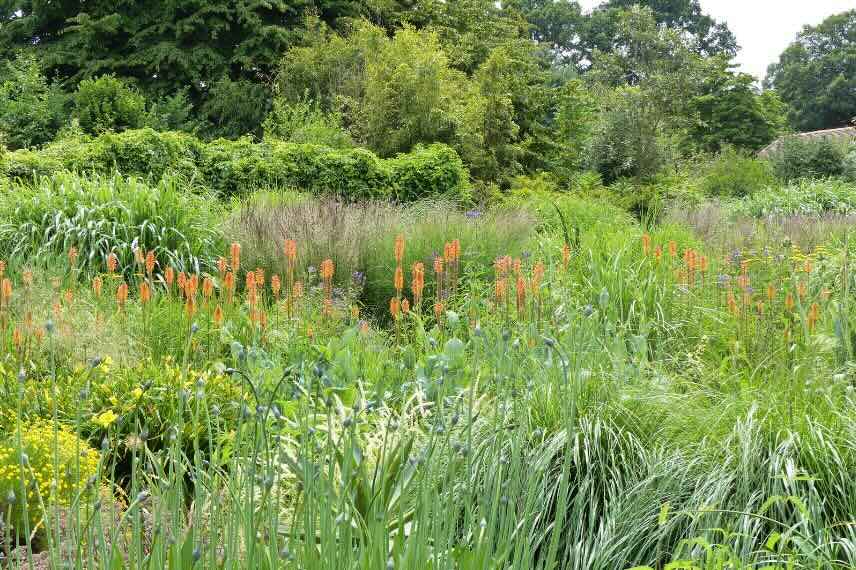
Tall ornamental grasses at the back of a border behind kniphofias
How to combine tall ornamental grasses in borders?
At the back of flower beds, tall ornamental grasses will mingle with various plants:
- bushes, interesting for their foliage (Japanese maple, palm tree…), their flowering (hydrangeas…) or their decorative wood (bamboos, dogwoods…);
- conifers;
- perennials with upright silhouettes such as Delphiniums, Eremurus, Dahlias, Japanese anemones;
- climbing plants;
- etc.
For example, tall ornamental grasses pair beautifully with roses at the back of flower beds. This creates either a romantic atmosphere if you choose roses with sophisticated flowering, or a rustic feel if you opt for varieties with single flowers and a natural look. A Panicum amarum, a tall grass reaching 1.5 metres with blue-green foliage, can perfectly accompany a climbing rose at the back of a flower bed, such as the ‘Décorosier Opalia’ climbing rose or ‘Libertas’. For further inspiration, check out our article: “Ornamental Grasses and Roses: A Winning Combination”.
Tall ornamental grasses with colourful foliage
Do you think ornamental grasses are a bit dull with their green foliage? In fact, there are varieties with colourful foliage that will be very interesting for brightening up the back of a border.
This is particularly true of tall grasses with variegated foliage. Among Miscanthus, we can mention Miscanthus sinensis ‘Strictus’, with its green leaves displaying golden-yellow lateral stripes. We should also mention ‘Cosmopolitan’, with its broad variegated leaves, green striated with white, just like ‘Cabaret’.
For its part, the Provence cane Arundo donax ‘Aureovariegata’ displays culms and leaves of green broadly striated with creamy yellow. As for ‘Variegata’, the green foliage striated with silvery white is very bright.
The sugar cane Saccharum officinarum violaceum delights us with dark green foliage tinged with red and purple.
We should also mention the reed Phragmites australis ‘Variegatus’, with foliage variegated in green and gold, which will whiten with age.
Among switch grasses, Panicum virgatum ‘Dallas Blues’ displays blue-green ribbons with metallic reflections.
Finally, although they are not grasses, Phormiums produce foliage that closely resembles them. Some varieties are particularly colourful, such as the large Phormium tenax ‘Purpureum’ with its purple ribbons.
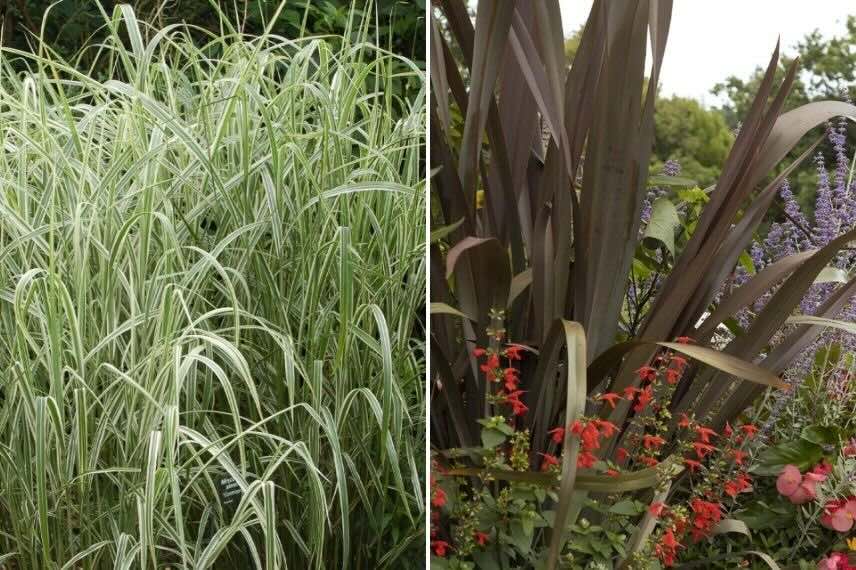
Miscanthus ‘Cosmopolitan’ and Phormium tenax ‘Purpureum’
Tall evergreen grasses
These are ornamental grasses that will retain their foliage all year round, brightening up borders even in winter. Covered in frost or snow, their delicate foliage will create beautiful, poetic scenes.
Consider, for example, the Golden Oats, impressive with its height of 2 metres and spread of 1 metre. It forms a dense clump, perfect at the back of a border for its striking volume. Its fine, light foliage has a blue-green hue and will persist in mild climates if frosts are not too severe or prolonged.
Another excellent choice is moor grass, such as the Molinia caerulea ssp arundinacea ‘Transparent’, with its arching, ribbon-like foliage that forms a true living fountain throughout the seasons.
We must also mention Mauritanian Vine Grass, less well-known perhaps due to its more limited hardiness (around -10°C). It forms a clump of trailing, light green leaves that remain in place even in winter.
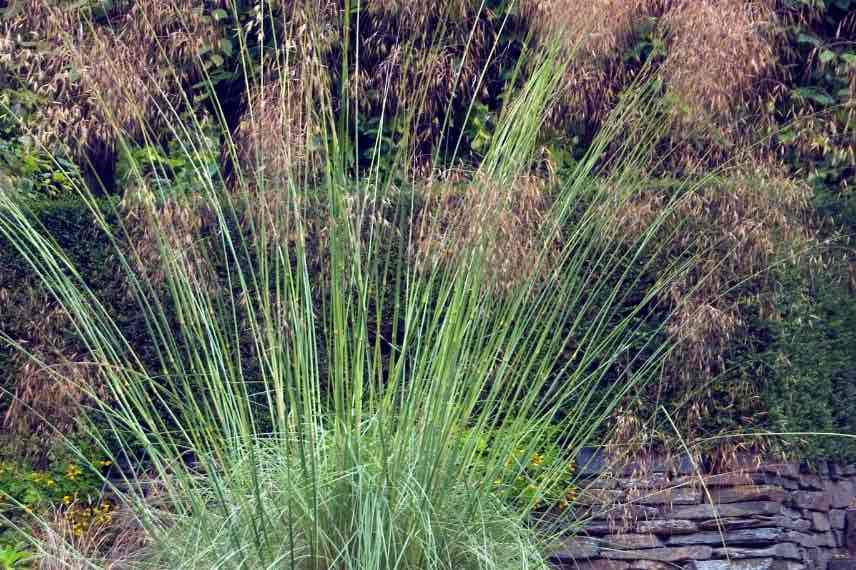
Stipa gigantea, tall flowering stems rising from a more modest evergreen clump
Tall ornamental flowering grasses
But ornamental grasses aren’t just about foliage. Some also boast highly interesting flowering. Often airy and very flexible, their undulate inflorescences sway with the wind, bringing movement and poetry to flower beds.
This is the case with Miscanthus, which produce lovely floral spikes – quite large in the variety ‘Roland’, pearly pink then white in ‘Kaskade’, coppery and fading to gold in ‘Sarabande’. They form silvery feathery spikes in Miscanthus transmorrisonensis.
Let’s also mention African feather grass, which produces long, highly ornamental cottony spikes, shifting from white to beige. Perfect for adding lightness to an autumn border!
In Calamagrostis acutiflora ‘Karl Foerster’, the foliage is adorned in summer with beautiful rose-bronze spikes, standing upright like tall plumes. A grass that will work wonders at the back of a border to create a light, graphic screen!
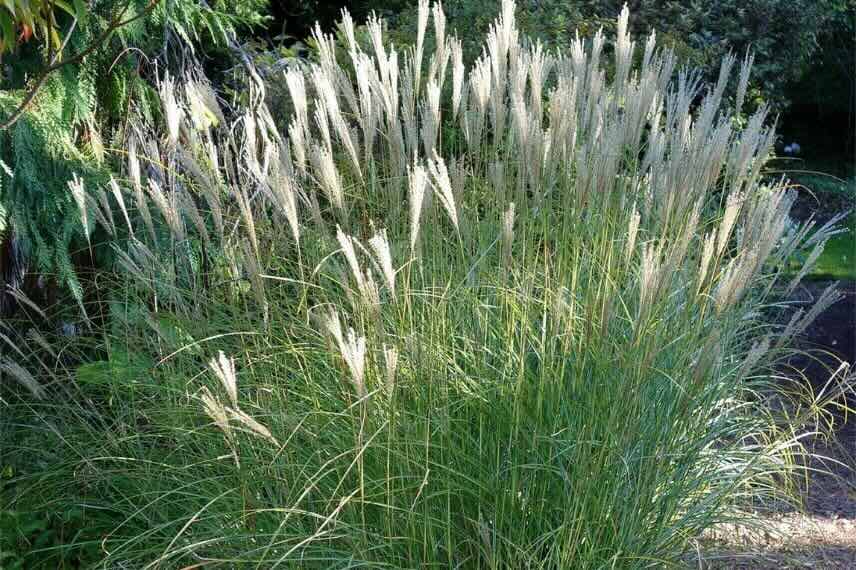
The flowering of Miscanthus transmorrisonensis
Tall ornamental grasses for damp border backdrops
To dress up a partially shaded border with fairly moist to wet soil, opt for the Giant Reed. It naturally thrives in the wetlands of Mediterranean regions. This plant will effortlessly structure the backdrop of your border with its tall, bamboo-like canes and trailing foliage.
Molinia also prefers moist soils and can even tolerate slightly chalky substrates.
Don’t overlook the Common Reed, which is perfect for creating a planting scheme near a water feature. It produces long, ribbon-like leaves and beautiful feathery spikes throughout the summer.
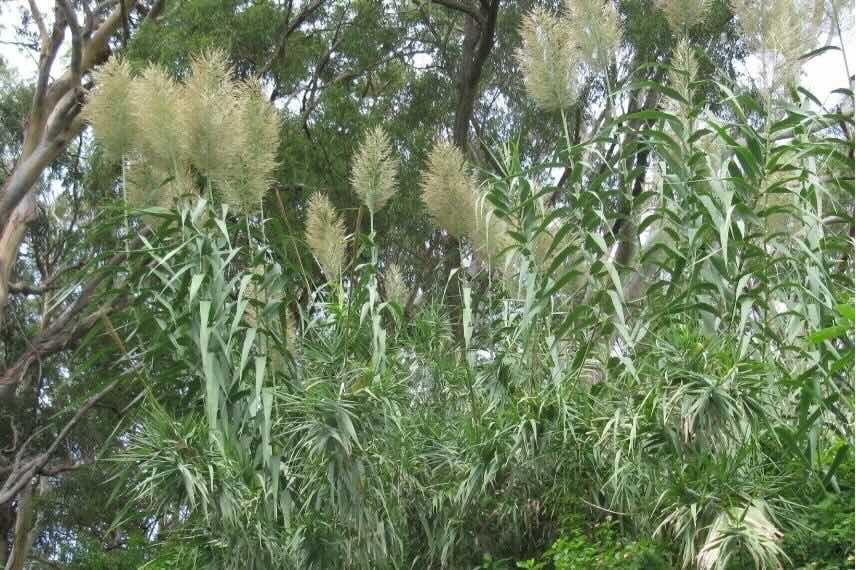
Arundo donax
Tall ornamental grasses for dry and sunny borders
On the other hand, some ornamental grasses prefer light, even poor soils, dry and well-exposed. This is the case with switchgrass, such as ‘Northwind’ with its broad blue-green leaves. Once established, it will withstand summer drought with ease and will always thrive in full sun.
Feather grasses also enjoy well-drained soils, even dry in summer, in bright exposures.
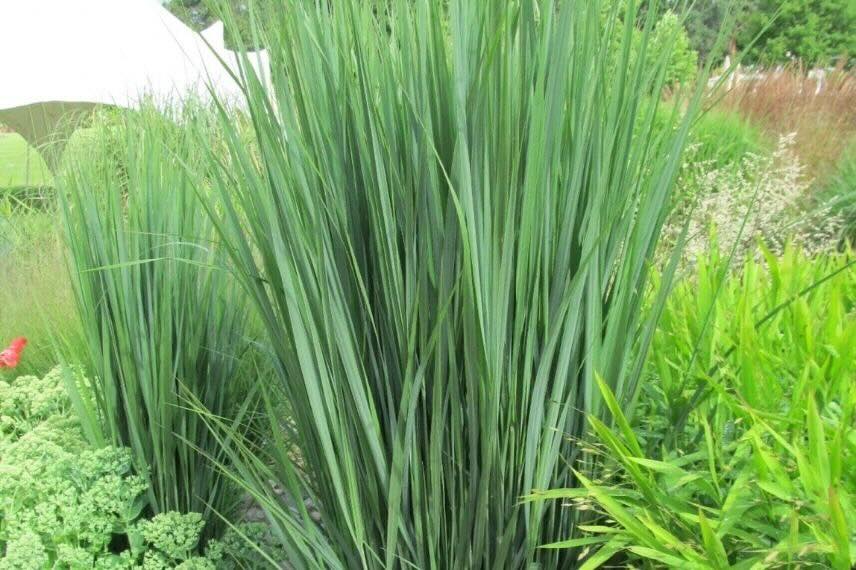
Panicum virgatum ‘Northwind’
Tall hardy ornamental grasses
If you live in an area with harsh winters, you’ll need to choose plants that can withstand severe frosts to adorn your flower bed. For tall, cold-resistant ornamental grasses, opt for Miscanthus, Panicum or common reed, all hardy beyond -25°C.
- Subscribe!
- Contents



































Comments